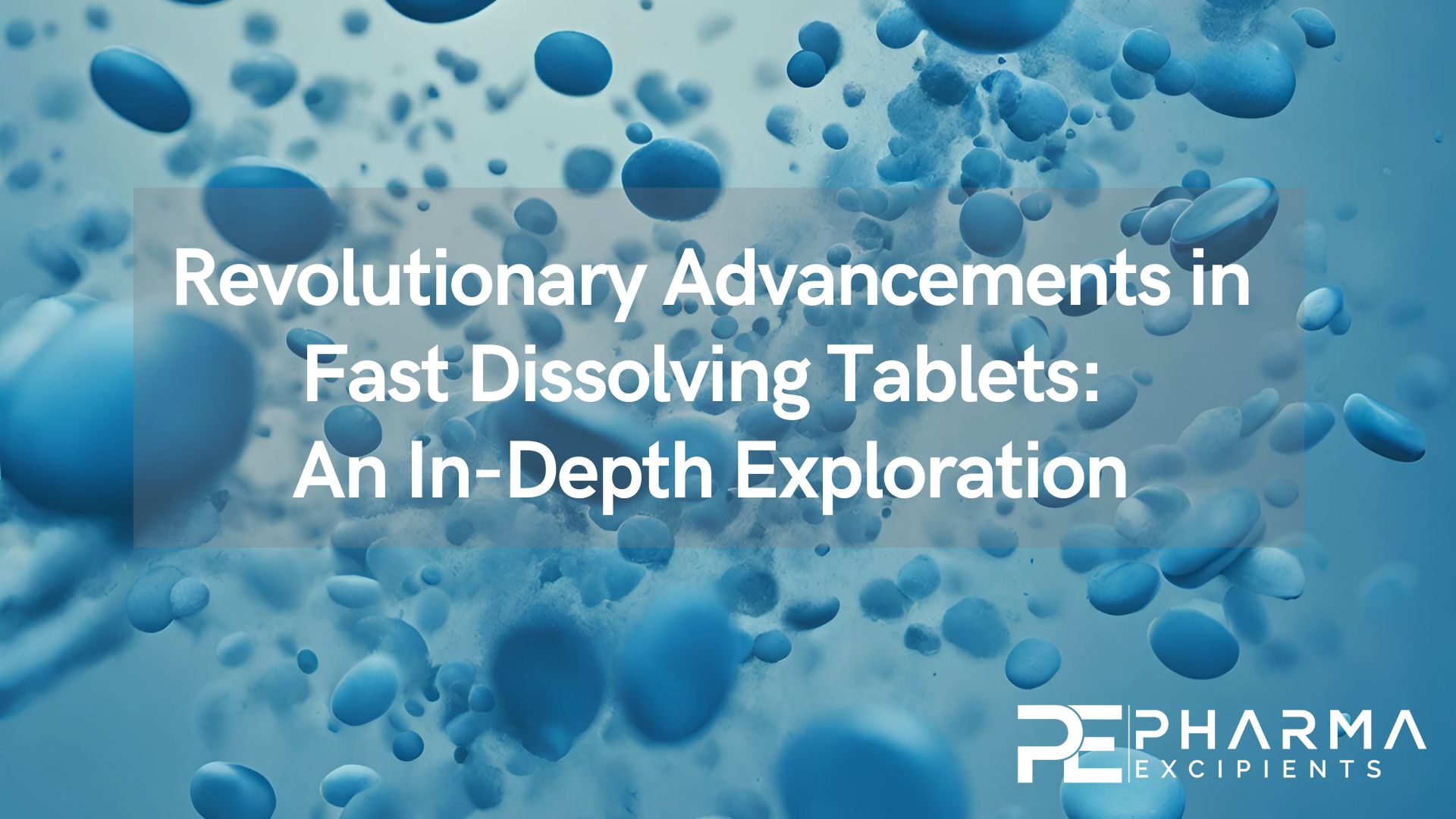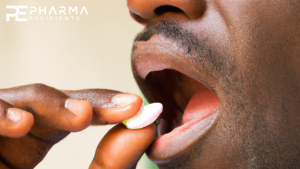Revolutionary Advancements in Fast Dissolving Tablets: An In-Depth Exploration

ABSTRACT
A novel drug delivery system plays a pivotal role in enhancing patient adherence to medication regimens. Among these innovative approaches, fast dissolving tablets (FDT’s) stand out as a particularly promising option. FDT’s offer a range of benefits, including precise dosing, ease of transport, streamlined manufacturing, robust physical and chemical stability, and they serve as an excellent alternative for both paediatric and geriatric patients. The formulation of FDT’s harnesses the advantages of both liquid and conventional tablet formulations, while also surpassing the merits of traditional dosage forms. In this comprehensive review, we delve into the advantages and limitations of FDT’s, the imperative need for their formulation, key formulation factors, the role of excipients, methodology, and critical evaluation parameters.
INTRODUCTION
Recent advancements in the field of novel drug delivery systems (NDDS) aim to improve the safety and reduce the toxicity of drug molecules. This is achieved by creating convenient dosage forms for administration and enhancing patient compliance. One notable innovation in this regard is the development of fast-dissolving tablets [1,2]. Fast dissolving drug delivery systems were initially introduced in the late 1970s as an alternative to traditional dosage forms, particularly for pediatric and geriatric patients. Traditional tablets and capsules, which require ingestion with an 8-ounce glass of water, can pose challenges for individuals who have difficulty swallowing solid oral medications. Fast dissolving tablets are specifically designed to rapidly dissolve or disintegrate in the saliva, typically within less than 60 seconds. These tablets are a suitable solution for patients facing such difficulties.
Fast-dissolving/disintegrating tablets (FDDTs) go by various names, including fast-melting, fast-dispersing, rapid dissolve, rapid-melt, and quick-disintegrating tablets. All FDDTs that have received approval from the Food and Drug Administration (FDA) are categorized as orally disintegrating tablets. Notably, the European Pharmacopoeia has adopted the term “Orodispersible Tablet” to refer to tablets placed in the oral cavity, where they rapidly disperse before being swallowed. The FDDT formulation offers a significant advantage by amalgamating the benefits of both liquid and traditional tablet formulations while surpassing conventional dosage forms. This innovation delivers the convenience of a tablet, coupled with the ease of swallowing typically associated with liquids. FDDTs also excel in providing precise dosing accuracy, outshining primary alternatives such as oral liquids [3].
The oral route of drug administration stands as the most widely accepted method, owing to its selfmedication convenience, compactness, ease of production, simple administration, precise dosing, safety, and cost-effectiveness [4-6]. Health care providers bear the responsibility of administering bitter drugs orally, especially when dealing with pediatric and geriatric patients, necessitating an acceptable level of palatability [7].
The most apparent drawback of commonly used oral dosage forms like tablets and capsules is the challenge of swallowing, particularly for pediatric and geriatric patients [5]. To address these medical requirements, pharmaceutical technologists have introduced a novel class of oral dosage forms known as orally disintegrating tablets (ODTs), fast disintegrating tablets (FDTs), mouth-melting tablets (MMTs), or mouth-dissolving tablets (MDTs). These tablets rapidly disintegrate in saliva, usually within seconds, eliminating the need for water. This results in enhanced drug dissolution, absorption, quicker onset of clinical effects, and increased drug bioavailability compared to conventional dosage forms [8,9]. When these tablets are placed in the oral cavity, saliva quickly infiltrates the pores, leading to rapid tablet disintegration [10].
Recent market studies reveal that more than half of the patient population prefers FDTs over other dosage forms. Mouth-dissolving tablets are primarily formulated using two techniques. The first method involves using superdisintegrants such as croscarmellose sodium, sodium starch glycolate, and crosspovidone. The alternative approach focuses on maximizing the tablet’s pore structure through freeze-drying and vacuum drying [8,9].
The absorption of certain drugs can be enhanced through oral cavity absorption and the pregastric absorption of saliva containing dispersed drugs that subsequently enter the stomach. This also results in a reduced amount of the drug being subjected to first-pass metabolism compared to standard tablets [11, 12].
Drug delivery systems (DDS) play a pivotal role in expanding markets, prolonging product life cycles, and creating opportunities. Among these systems, oral administration stands out as the most widely adopted method for achieving systemic effects due to its simplicity of consumption, pain avoidance, versatility, and, most importantly, patient adherence. Solid oral delivery systems offer the advantage of not requiring sterile conditions, thus reducing manufacturing costs. Tablets, with their advantages of patient compliance, precise dosing, and manufacturing efficiency, remain the preferred solid dosage form. Changes in solid dosage form technologies in response to evolving drug discovery, such as genomics, could significantly impact the choice of excipients and equipment [13-16].
Injections are generally less favored by patients, unless facilitated by advanced auto-injectors. Inhalation presents an alternative method for drug delivery; however, current research on biopharmaceuticals has primarily yielded chemical entities with low molecular weights. The development of fast-dissolving tablets for enhanced oral protein delivery holds great promise for delivering high molecular weight proteins and peptides. Nevertheless, the oral route remains the ideal choice for administering therapeutic agents due to its cost-effectiveness, ease of administration, and resulting high levels of patient compliance [17-20].
Table 2: List of Superdisintegrants [47]
| Superdisintegrants | Example | Mechanism of Action | Special comment |
|---|---|---|---|
| Crosscarmellose® Ac-Di-Sol® Nymce ZSX® Primellose® Solutab® Vivasol® L-HPC | Crosslinked cellulose | -Swells 4-8 folds in < 10 seconds. -Swelling and Wicking both. | -Swells in two dimensions. -Direct compression or granulation -Starch free |
| Crosspovidone Crosspovidon M® Kollidon® Polyplasdone® | Crosslinked PVP | -Swells very little and returns to original size after compression but act by capillary action | -Water insoluble and spongy in nature so get porous tablet |
| Sodium starch glycolate Explotab® Primogel® | Cross linked starch | -Swells 7-12 folds in < 30 seconds | -Swells in three dimensions and high level serve as sustain release matrix |
| Alginic acid NF Satialgine® | Crosslinked alginic acid | -Rapid swelling in aqueous medium or wicking action | -Promote disintegration in both dry or wet granulation |
| Soy polysaccharides Emcosoy® | Natural super disintegrant | -Does not contain any starch or sugar. Used in nutritional Products |
|
| Calcium silicate | -Wicking Action | Highly porous, Optimum concentration is b/ 20- 40% |
Download the full article as PDF here: Revolutionary Advancements in Fast Dissolving Tablets
Shabana Parveen, A. Ramu, Int. J. in Pharm. Sci., 2023, Vol 1, Issue 9, 427-446 | Review, Published: 27 Sept 2023, DOI: 10.5281/zenodo.8381942
Read also more on Orally Disintegrating Tablets (ODTs) here:


